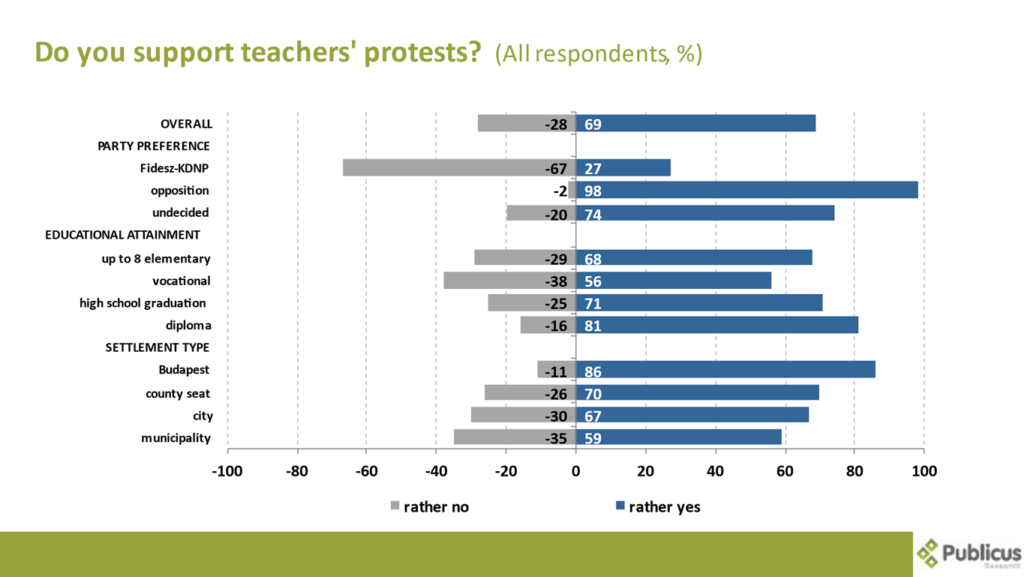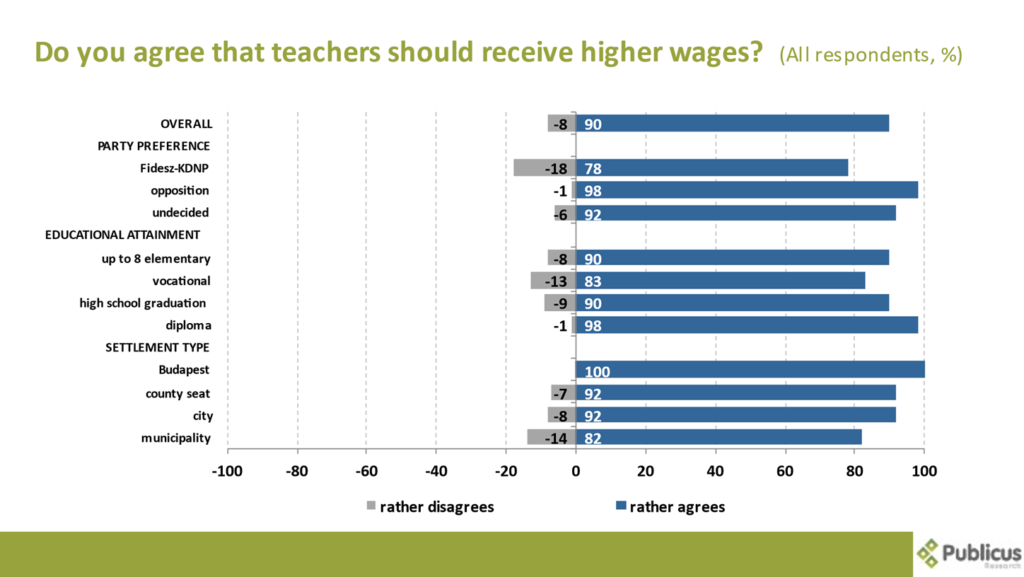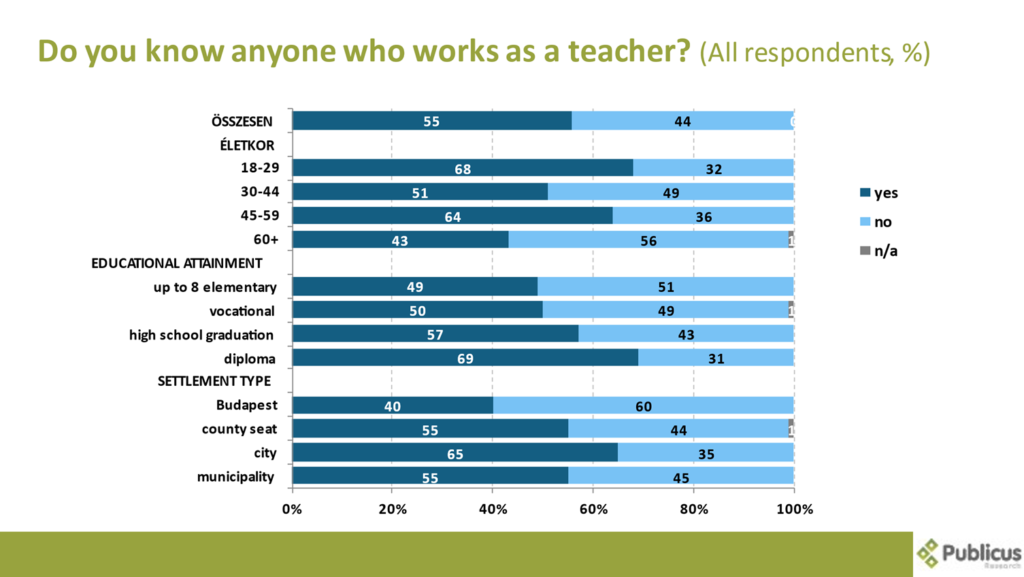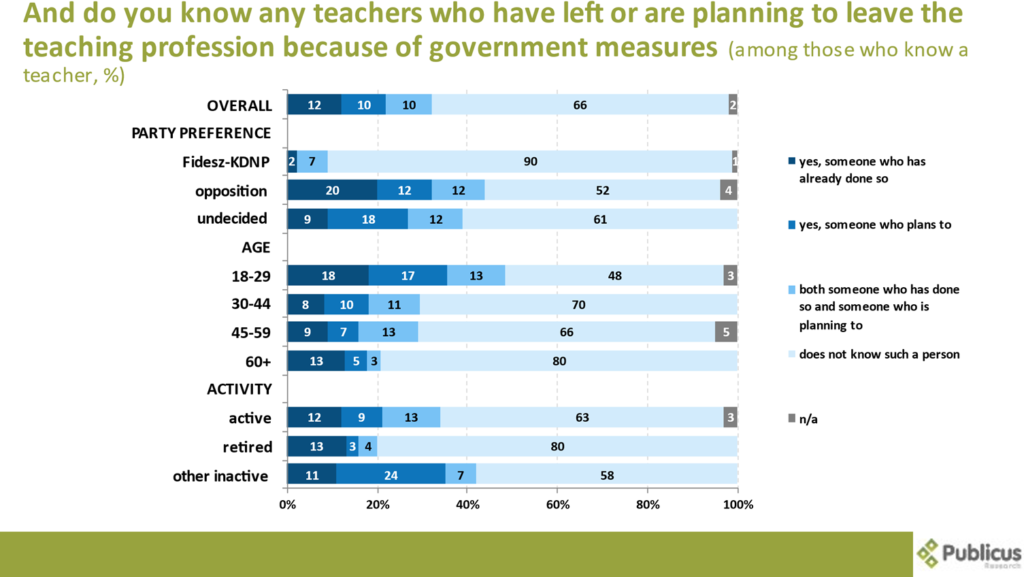Publicus Institute, commissioned by Népszava, asked people about the issue of education in a national representative opinion poll conducted between May 05th and 10th , with 1003 respondents.
(Ezen kutatás magyar nyelven itt olvasható.)
Seven out of ten respondents support the teachers’ protest. Nine out of ten agree that teachers should receive higher salaries.
One in five would think a salary of around 530,000 forints (the equivalent of the average gross salary) would be fair for teachers. One fifth of respondents would give teachers between HUF 530,000 and 610,000 gross, and one third would give teachers more than HUF 610,000 gross.
The majority of respondents have friends who work as teachers. One in three of them knows someone who has either left their teaching career or is planning to do so, or both.
Seven in ten (69 per cent) respondents support the teachers’ protest. Almost all (98 per cent) of voters from opposition parties who cooperated in the election, three-quarters (74 per cent) of undecided voters and a quarter (27 per cent) of Fidesz voters said the same.
The highest support for the teachers’ protest is among graduates (81 percent) and Budapest residents (86 percent), and the lowest among skilled workers (56 percent) and people living in rural areas (59 percent).

Nine in ten (90 per cent) agree that teachers should receive higher salaries. Almost all (98 per cent) of voters of the opposition parties who co-operated in the election, nine out of ten undecided voters (92 per cent) and eight out of ten (78 per cent) Fidesz voters said the same. Here too, graduates and residents of Budapest are the most in favour of higher wages (98 and 100 percent), while those living in rural areas and skilled workers are the least in favour (82 and 83 percent), but here too there is clearly a clear trend of strong support.

One in five (20 per cent) respondents would consider a salary of around 530,000 forints (equivalent to the average gross salary) to be fair for teachers. One fifth of Fidesz voters and one fifth of undecided voters (23 and 25 per cent respectively) and one in six of voters of opposition parties who co-operated in the elections (16 per cent) would consider this amount fair. Furthermore, this amount is mostly considered fair by skilled workers (30 per cent) and those living in the county’s capital (27 per cent).
A third of those polled (35 per cent) would consider more than 115 per cent of the average salary, i.e. more than 610,000 HUF gross, to be fair for teachers. One in two (47 per cent) voters of the opposition parties who co-operated in the elections, three in ten (30 per cent) undecided voters and one in five (21 per cent) Fidesz voters think so. Furthermore, this amount is most likely to be considered fair by graduates (42 percent), those living in Budapest and those living in cities (43 and 42 percent respectively).
Nearly one in five (18%) respondents would consider a salary of 100-115% of the average wage, i.e. HUF 530-610 thousand, to be fair. This is the view of nearly a fifth of all political sides (16-20%).
One in five (20%) would consider a salary below the average gross salary (HUF 530,000) to be fair. Three in ten (31 percent) Fidesz voters, nearly one in five (17 percent) undecided voters and one in six (15 percent) voters of opposition parties who co-operated in the elections think so. Furthermore, those who have only completed high school (24 percent) and those who live in rural areas (25 percent) are the most likely to think so.

The majority of respondents (55 percent) know someone who works as a teacher. The respondents most likely to say this were 18-29 year olds (68 percent), 45-59 year olds (64 percent), graduates (69 percent) and those living in cities (65 percent).

Among those who have a teacher acquaintance, one in eight (12 percent) said they knew of someone who had left teaching as a result of government measures. This was the view of a fifth (20 per cent) of voters from opposition parties who co-operated in the election, a tenth (9 per cent) of undecided voters and 2 per cent of Fidesz voters.
One in ten respondents (10 per cent) know someone who is planning to leave teaching. This was said by nearly a fifth (18 per cent) of undecided voters and one in eight (12 per cent) of voters from opposition parties who co-operated in the election.
One in ten (10 per cent) of those polled knows both teachers who have already left the profession and teachers who are planning to do so. One in eight (12 per cent) of voters from opposition parties who co-operated in the elections, one in eight (12 per cent) of undecided voters and 7 per cent of Fidesz voters also said this.
Two-thirds of respondents (66 percent) do not know any teachers who have left the teaching profession because of government measures. Nine in ten (90 per cent) Fidesz voters, six in ten (61 per cent) undecided voters and half (52 per cent) of voters from opposition parties who co-operated in the election say this.
Half of 18-29 year olds (48 per cent) know a teacher who has either left their career (18 per cent) or is planning to (17 per cent), or both (13 per cent). For those aged 60 and over, the overall proportion is much lower: 21 per cent.

More details on the results of the survey can be found in the print and online editions of Népszava. When reporting on the survey, please also refer to Népszava.
Methodology
The survey was conducted by Publicus Institute as a part of Publicus Omnibusz, between the 5th and the 10th of May 2023, polling 1003 individuals via phone, who are representative of the adult population of Hungary. The potential distortions of sampling were corrected with weighting based on the data from the 2016 KSH census data. The attributes of the surveyed accurately resemble those of the Hungarian population by their sex, age, educational attainment, regional and settlement wise composition. With this sample size, we can state with a 95 percent confidence level that the data obtained through testing would only differ by +/-3,1 percent at most from that we would have gotten when surveying all 18 year old or older residents. The statistical error is larger however, when the distribution is configured not to all surveyed, but to certain smaller subgroups.















